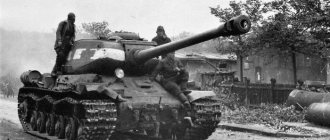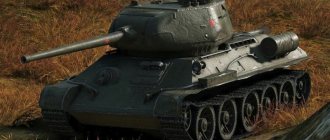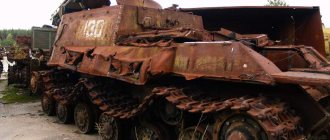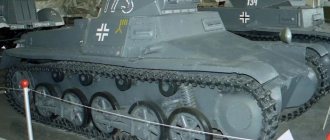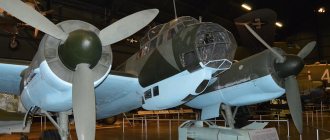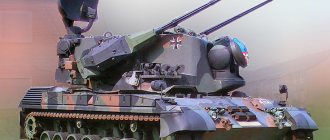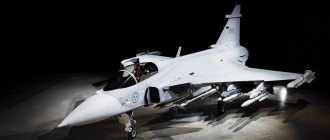Birth of a Hero
They began to think about creating a new heavy tank in the spring of 1942. It was then that the modernized German Pz-4 tanks and StuG-III self-propelled guns with reinforced armor and improved guns first went into battle. In addition, the Germans began to use cumulative shells, which caused real devastation in the ranks of Soviet tanks.
The project to create a new tank was supervised by Joseph Kotin. He was one of the most experienced designers of the USSR, who gained enormous experience in designing heavy tanks, in particular, it was he who became the father of the KV family. “Klim Voroshilov” was not without its shortcomings, ranging from low reliability to very difficult working conditions for the crew. The direct designer of the tank was Nikolai Shashmurin, whom Kotin knew very well from his work in the 30s at the Kirov plant in Leningrad.
Initially, it was a question of a vehicle weighing 30 tons and with an 85 mm cannon. Tank builders tried to create a universal vehicle that combined good mobility with survivability. The first sample was designated KV-13. During testing, the new car completely failed: the chassis turned out to be unreliable. Refinement of the KV-13 led to the appearance of prototypes with different weapons systems. One of the versions had a 76-mm cannon, similar to the one used on production KVs. However, for the heavy tank of the second half of the war, something more powerful was required.
In the fall of 1942, the designers came across a damaged “tiger”. Moreover, it is practically in working order, even with technical documentation. An equally significant event was the meeting of the Red Army soldiers with the latest developments in German field fortification. These included, for example, the mass-produced armored machine gun nest of the “Crab” type. The armored cap, made entirely of armored steel, was recessed into a specially dug pit, after which only the embrasure and the roof remained sticking out.
In short, it became clear that the troops needed a vehicle armed with a cannon capable of hitting even a very well-protected target. The shelling of captured “tigers” led to a clear conclusion: the caliber needs to be increased. True, more powerful weapons inevitably led to an increase in dimensions: the vehicle spread out in width, the mass grew. The idea of creating an ideal tank with high speed, armor protection and firepower was abandoned, and mobility fell victim.
At first they thought to limit themselves to a gun with a caliber of 85 mm. Such a gun was quite suitable for a medium tank, but Kotin insisted on installing an even more powerful weapon: at a typical tank battle distance, medium enemy armored vehicles could be knocked out with an 85-mm gun, but heavy armored vehicles could no longer be knocked out. As a result, Kotin and his team decided to experiment with a 122 mm gun.
The 122-mm A-19 hull gun was chosen as the base model. It was a powerful artillery system, and Perm Plant No. 172 mastered them long ago and produced them quite intensively. In the fall of 1943, a preliminary design was ready, which impressed the People's Commissar of the Tank Industry Vyacheslav Malyshev, and then Stalin. The new model created an even greater sensation at the training ground, where a captured “Panther” was shot from it. From a distance of one and a half kilometers, the projectile literally turned around the “cat” tower, piercing through it. True, the muzzle brake on the gun exploded. Fortunately, no one was killed, and the brake design had to be completely redesigned.
The new tank had some disadvantages. Firstly, the extremely poor rate of fire for a tank gun (only 1.5–3 rounds per minute) did not allow the enemy to be bombarded with shells at a high rate. Another serious problem with the IS-2 was its low ammunition load. Tankers often tried to put more shells into their vehicles.
However, much better survivability compared to any medium tank and, most importantly, a powerful weapon made up for everything. IS-2 went into production.
IS-2 (IS-122), Heavy tank
HEAVY TANK IS-122 (IS-2, Joseph Stalin, object 240)
The first version of the IS heavy tank ("Joseph Stalin") with an 85-mm D-5T cannon (object 237) was developed in the summer of 1943 at the Chelyabinsk Kirov Plant under the leadership of lead designer N.F. Shashmurin. On August 7, by decree of the State Defense Committee, the tank was accepted into service. Serial production of the IS-1 (or IS-85) began at the end of October.
With a mass of 44 tons, which slightly exceeded the mass of the KV-1s tank, the new combat vehicle had thicker armor. The turret, frontal part and turret part of the hull were cast. The installation of small-sized planetary rotation mechanisms (PMP) designed by A.I. Blagonravov made it possible to reduce the width of the IS-1 hull by 18 cm compared to the KV-1s.
Almost simultaneously with the IS-1, production of a more powerfully armed model, the IS-2 (object 240), began. The newly created 122-mm D-25T tank gun (originally with a piston bolt) with an initial projectile speed of 781 m/s made it possible to hit all main types of German tanks at all combat distances. On a trial basis, an 85-mm high-power cannon with an initial projectile speed of 1050 m/s and a 100-mm S-34 cannon were installed on the IS tank.
At the beginning of 1944, production of the IS-1 tank was stopped (107 vehicles were produced). From that moment on, only the IS-2 was in production. Soon the sighting devices on it were changed (in particular, the PTK-5 periscope sight was removed) and the gun's armored mantlet was expanded. From mid-1944, the IS-2 began to be produced with a sloping frontal part of the hull without a driver's inspection hatch (the so-called “plug”), but with a gap closed by a glass block. In addition, a large-caliber anti-aircraft machine gun DShK was introduced, which, however, was not installed on all tanks. The IS-2 was accepted in this form. participation in the final battles of the Second World War. After the production of 3,483 tanks in mid-1945, production ceased.
IS-2 tanks entered service with separate heavy tank regiments, which were given the name “Guards” during their formation. At the beginning of 1945, several separate guards heavy tank brigades were formed, including three heavy tank regiments each.
On the basis of IS tanks, self-propelled guns ISU-152, ISU-122 and ISU-122S were serially built, and a number of prototypes of self-propelled guns with guns of 122, 130 and 152 mm calibers were created (objects 243, 247, 251, etc.).
TACTICAL AND TECHNICAL CHARACTERISTICS OF THE IS-2 TANK
COMBAT WEIGHT, t: 46. CREW, people: 4. OVERALL DIMENSIONS, mm: length – 9830, width – 3070, height – 2730, ground clearance – 420. ARMAMENT: 1 gun D-25T mod. 1943 caliber 122 mm; 3 DT machine guns of 7.62 mm caliber: 1 DShK machine gun of 12.7 mm caliber (not on all tanks). AMMUNITION: 122 mm rounds – 28; 12.7 mm cartridges – 300; 7.62 mm cartridges - 2331. AIMING DEVICES: telescopic sight 10-T-17, periscope sight PT-3-17 (on tanks of the first releases). RESERVATION, mm: front – 120, side – 90, stern – 60, roof, bottom – 20-30, turret – 160-90. ENGINE: V-2-IS, 12-cylinder V-shaped diesel liquid cooled; displacement 38,880 cc; maximum power 520 hp (382.5 kW) at 2000 rpm. TRANSMISSION: multi-disc main dry friction clutch, eight-speed gearbox with a range control, planetary turning mechanisms, final drives. CHASSIS: six track rollers with internal shock absorption on board, three support rollers, rear drive wheels with removable ring gears (lantern engagement), idler wheel; The suspension of the road wheels is individual torsion bar: each track has 86 tracks with a width of 650 mm, the track pitch is 162 mm. SPEED, max., km/h: 37. POWER RESERVE, km: 240. OBSTACLES OVERCOME: climb angle, degrees. – 36; ditch width, m-2.5, wall height, m-1, ford depth, m – 1.3. COMMUNICATIONS: radio station 10R or 10 RK, tank intercom TPU-4-bisF.
Armament
The main weapon of the IS-2 is the D-25T cannon of 122mm caliber. The prototype was the towed A-19 gun - the guns of early tanks even had a similar piston breech; later, to increase the rate of fire, it was replaced with a semi-automatic wedge unit. The prototype gun had a T-shaped muzzle brake; vehicles with a muzzle brake copied from the German model went into production. Later it was replaced with a more efficient two-chamber brake.
The ammunition load is small - only 28 rounds of separate cartridge loading.
During the war, only two types of ammunition were used - armor-piercing chambered BR-471 and high-explosive fragmentation OF-471. Both had a mass of 25 kg and an initial speed of 800 m/s, the explosive charge of the armor-piercing projectile contained 125 g of hexal, and the fragmentation charge - 3.6 kg of TNT.
Despite the absence of a radio operator in the crew, there was a DT machine gun, rigidly mounted in the right “chine” of the hull. The mechanic-driver fired it using an electric trigger. The second diesel engine was paired with the gun, and the third was installed in the rear plate of the turret. The top of the turret, or rather the commander's cupola, had a turret mounting with a DShK machine gun - one of the first cases of installing a standard anti-aircraft machine gun on Soviet armored vehicles.
In addition, early models had embrasures on the sides of the turret for firing from personal weapons.
Use in combat
ISs with an 85mm cannon went into battle in February 1944. The first use was unsuccessful - all the tanks that stormed the village of Lisyanka were knocked out. Based on the results of further battles, which included, among other things, clashes with Tigers, it finally became clear that the D-5 gun was not suitable for the IS. But the IS-2 with the large-caliber D-25T cannon turned out to be very useful. Moreover, it was not used so often in the role of an “anti-tank” weapon. But he turned out to be indispensable when breaking through defensive lines.
Powerful IS-2 shells easily destroyed fortifications that were invulnerable to smaller caliber guns, and from a great distance.
And the main opponent of the Soviet “heavyweights” was not the “Tigers”. The majority (up to 70% percent in urban battles) of IS-2 tank losses were caused by Panzerfausts, disposable grenade launchers produced in huge quantities.
According to veterans, the cumulative jet and fragments of armor incapacitated the crew, even if the tank itself remained practically undamaged. To protect against “Fausts,” improvised anti-cumulative screens were installed on armored vehicles (including the IS-2).
By the end of 1944, separate brigades began to be formed from heavy tanks. Two such brigades were involved in the assault on Berlin. During the Second World War, the Polish and Czechoslovak armies formed in the USSR were armed with IS-2 tanks. After the war, the IS-2 was supposed to be replaced with new vehicles, but due to their imperfections, the model of the tank, tested in production and mastered in operation, remained in service. In the 50s, the ISs were modernized and remained in service even after the start of production of the T-10 tank.
The outdated ISs found use in the fortified system on the Chinese border.
The tank was officially withdrawn from service only in the 90s. A certain number of IS-2s were transferred to Cuba, North Vietnam and the DPRK.
Modifications
The released IS-2 tanks, despite the design differences, were not separated into separate modifications. Only in 1957, after the decision was made to modernize the vehicles, the IS-2M version appeared - the vehicles were converted into it during a major overhaul.
The IS-2M was equipped with new V-54K engines, a gearbox oil cooler, and night vision devices. The rear machine gun was abolished, the ammunition load was increased (increased to 35 rounds), and the external tanks included a general power supply circuit. All surviving vehicles were brought to the new standard, including the IS-2 of the first production with a “broken” frontal part.
Variants such as “IS-2Sh” appearing in some online games are fiction.
"War elephants" of tank forces
During the offensive, ISs protected the flanks and fought against counterattacking enemy tanks.
They moved behind the battle formations in a column or in separate groups. They were also used to capture individual strong points and road junctions. For this purpose, the tank brigade was assigned a platoon or company of ISs supporting the first echelon tanks. Heavy vehicles moved in a line, 200–300 m from the “thirty-four” of the first echelon. They were an unpleasant, deadly surprise for German tanks trying to counterattack or ambush the T-34s. The 46-ton IS-2 was a formidable opponent for any German tank - both when operating in a group and in one-on-one combat. In
defense, the IS-2 repelled attacks by German armored vehicles, destroyed firing points and artillery. The tanks moved into the area of probable enemy attack and lined up in a checkerboard pattern - from one and a half to two kilometers wide and up to three kilometers deep. It was also practiced to place a small number of ISs on the front line along with T-34s, while keeping the main heavy forces about five kilometers behind in order to control all possible routes of enemy attack.
The key to successful operations of heavy tanks was constant thorough reconnaissance. It was necessary to know not only about the enemy, but also about the details of the area. The Thirty-Fours were capable of passing through swamps, sand, and light bridges. But forty-six-ton ISs could, if not get stuck, then wear out the chassis ahead of time. If it was necessary to pave the way for them, the efforts of the sapper platoon could easily not be enough. And this threatened to disrupt the combat mission.
Before the battles, the tank crews carefully prepared. All officers received maps with the situation marked, and the crews, down to each driver, became familiar with the terrain and the front line of the enemy defense. The crew of each tank knew the plan of action for their regiment in a breakthrough.
The IS-2 was reliable and, with skillful care, could travel up to 100 kilometers per day, significantly exceeding the engine hour warranty.
Guards "sledgehammer" in action
After reconnaissance found out where the enemy was, the IS-2s sought to engage in battle at a distance of 1200–1500 m, where the guns of Soviet tanks, according to the crews, were superior to German ones. The 122-mm cannon of this tank was generally considered the best means of fighting enemy tanks at long distances. And although post-war authors often criticized the IS-2 for its small supply of shells, as a rule, one ammunition load of the vehicle was enough for a day of intense battle. What the tankers themselves didn’t like about the gun was the large smoky cloud that unmasked the tank with every shot.
In August 1944, three IS-2s destroyed six of the most modern German “Royal Tiger” tanks without losing a single vehicle from enemy fire.
Although the first IS-2 sights lacked visibility, battles in 1944 showed that this tank was capable of hitting the German Panther in any position at a distance of up to 1,300 meters, and earlier tanks - at a distance of up to two kilometers. Since July 44, the ISs received a new sight, which, as they wrote in combat reports, ensured “the tactical superiority of our sights over similar German models.”
An 88-mm German shell penetrated the armor of early series IS-2s at a distance of 800–1000 m. If Soviet tankers were careless, they came under German flanking fire. But if the ISs fought according to instructions, moving in leaps and bounds following the T-34 battle formations, acting in pairs, supporting each other and conducting thorough reconnaissance, then the enemy had a hard time.
A skilled crew, even in one-on-one combat, is capable of destroying the most dangerous enemy equipment. For example, in the battles on the Sandomierz bridgehead in just one day, August 13, 1944, three tanks of lieutenants Klimenkov, Udalov and Belyakov destroyed six Royal Tigers with fire from prepared positions. There were no losses on our side.
On July 20, 1944, near the city of Mageruv, Lieutenant Boris Slyunyaev, under the cover of a second tank, secretly moved to the crossroads and watched the enemy ambush for 10–15 minutes. After all the firing points were spotted, Slyunyaev’s tank destroyed the Ferdinand self-propelled gun, an armored personnel carrier and two guns with crews with several accurate shots from a kilometer away. In August 1944, the same Slyunyaev, covering the crossing of the Vistula, together with the T-34 and artillery, repelled 12 attacks in three days of fighting, burned a Tiger, a self-propelled gun, and destroyed about 50 German soldiers. In August, the regiment where Slyunyaev fought announced the destruction of a 128-mm self-propelled gun - probably another Ferdinand. And in 1945, near the city of Lubenau, Slyunyaev destroyed an armored train.
According to the recollections of Soviet tank crews, heavy German tanks avoided attacking areas where ISs were defending.
In the battles of March 1945, the 82nd IS-2 regiment fired about three rounds of ammunition per day, destroying 13 tanks and self-propelled guns, 42 guns, capturing 5 self-propelled guns and 40 locomotives. In Berlin, where IS-2s were used in street battles, ammunition consumption also reached two or three rounds of ammunition per day.
After the war, tankers rightfully said: “There are difficult tasks, but there are no insoluble tasks. We have “U” in the cube: saw, hit, destroyed. If we catch anyone, he will not leave alive.”
Performance characteristics in comparison with enemy analogues
The only analogue of the IS-2 during the war was actually the famous Pz.VIB - “Royal Tiger”. Let's compare their main tactical and technical characteristics.
| IS-2 | Pz.VIB | |
| Weight, t | 46 | 70 |
| Length, m (hull/with gun) | 6,7/9,8 | 7,3/10,2 |
| Height, m | 2,6 | 3 |
| Maximum armor thickness, mm | 120 | 150 |
| Armament | 120mm cannon, 12.7mm machine gun, 3x7.62mm machine gun | 88 mm cannon, 3x7.92 mm machine gun |
| Maximum speed, km/h | 37 | 38 |
| Cruising range, km | 240/160 | 150/70 |
It is easy to see that in terms of mass and size parameters, the IS-2 was inferior to the Tiger 2 - that is, it weighed 20 tons less and was a little more compact. This gave it both better mobility and cross-country ability, even with a less powerful engine.
Of course, the Tiger had more ammunition (up to 84 rounds) and a higher rate of fire, but in practice these qualities were not usually decisive in tank duels.
The main thing is that every “Royal Tiger” released literally ruined the German industry, despite the fact that there was not much use from it on the fronts.
The IS-2 turned out to be a very successful machine precisely for the period of the war in which it was used.
It was in offensive operations that this mobile but well-protected vehicle with a powerful long-range cannon showed its best side. In a sense, it became the heir not to the KV-1, but to the KV-2, a powerful assault tank, having, unlike its “ideological ancestor,” a huge influence on the course of the war.
Anatomy of a tank elite
Even before the Great Patriotic War, Marshal Semyon Mikhailovich Budyonny said: “The Red Army is strong, but communications will destroy it.” Therefore, to provide heavy tank regiments - the most important strike instrument of the Soviet troops - they tried to allocate as many communications equipment as possible. The headquarters of each IS-2 regiment had several radio stations - both for communication between their vehicles and for maintaining contacts with the top. The staff radios were on duty 24 hours a day, and the tank radios were turned on every hour for a few minutes. Therefore, both the headquarters and the regiment commander could freely contact the company commanders and any tank individually at any time. During long stops, the tank corps provided the heavy regiment with telephone communications. At the headquarters there were liaison officers from each tank company. The regiment also had coherent armored cars and motorcycles. So in the guards regiments, communications worked without interruption, which, alas, was uncharacteristic for tank forces as a whole.
How did ISs go into battle? Combat reconnaissance consisted of a platoon of tanks, a platoon of sappers on an armored personnel carrier, and a couple of squads of machine gunners (about 20 people). The reconnaissance was moving 5–7 km ahead. Following her, also in front of the main forces, was a marching outpost, similar in composition, but without sappers.
To avoid being ambushed, the regiment commander rode not at the head of the column, but in the third tank. The main convoy was accompanied by a task force: a fast Willys all-terrain vehicle, an armored personnel carrier with a staff radio, an armored vehicle and a couple of motorcycles for communication.
Behind the tanks were trucks with fuel, ammunition and food, ambulances and repair vehicles, and a kitchen. When meeting the enemy, the tanks deployed into battle formation, the task force took a place behind the main forces, and the other vehicles retreated to cover.
The infantry, if necessary, sent messengers and guides and guarded the tanks at night.
